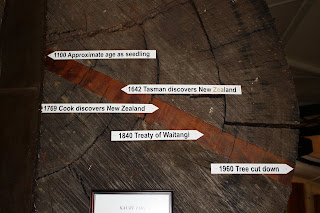We had worked pretty hard on the boat and the entire crew felt like we needed a break and to enjoy some of the local area. We hopped into our trusty rental car and drove an hour or so south to visit a museum all about the massive Kauri trees that were a large industry in early New Zealand history.
The Kauri Museum, Matakohe tells the story of the pioneering days through the use of kauri timber and kauri gum. There were many exceptional displays and galleries inside the museum, from a magnificent collection of antique kauri furniture and the largest collection of kauri gum in the world, to restored machinery, including NZ’s earliest tractor, a 1929 Cat 60, and a turning steam sawmill. We saw a two story life-sized replica Boarding House, a Pioneer School and the historic Matakohe Post Office with a fantastic collection of telephones.
The size and age of the trees was impressive. The photo below of one 860 year old tree was cut down when Kim and I were 3 years old.
Back in the states making furniture as a hobby, I was thrilled to get my hands on a old cherry board that was 16 inches wide. They had a board on display that was 6 ½ feet wide and over 19 feet long. The photos showed how the men were dwarfed by the large heavy log pieces and told how many had lost their lives as an errant log tumbled down a slope crushing several men.
Kauri gum is a resin which bleeds from the kauri tree. If the bark is damaged or a branch is broken by the wind, the resin bleeds out and seals the wound. This prevents rot or water getting into the tree. Kauri gum can build up into a lump which goes hard. As the tree grows, the bark is continually shed and the kauri gum is forced off and falls onto the ground around the tree. This process has been happening for millions of years, long before mankind began to use kauri gum. Many years ago, there were vast quantities of gum in the ground.
Kauri gum was used commercially in varnish. Kauri gum was exported to London and America from the mid 1840's. It was used to a limited extent in paints during the late nineteenth century, and from 1910 was used extensively in the manufacture of linoleum. Kauri gum was Auckland's main export in the second half of the nineteenth century.
New Zealand has fossil kauri gum in coal dated 43 million years old. More recent kauri gum from 10,000 to 30,000 years old is known as kauri copal (or resinite). Kauri gum was collected from the ground by picking up the exposed pieces on the surface. As this disappeared, gum diggers probed in the ground with gum spears to find the gum, then dug it up with spades.
Trees were also a source of gum. Kauri gum collectors would chip pieces of old hard gum from the branches and heads of trees where it had collected for many years. They also cut the trees to bleed fresh gum. This was collected later after it had developed into a hard lump.
Examples of exquisitely beautiful polished kauri gum were on display. Special pieces were polished and carved to make extremely beautiful collection pieces.
We had a nice lunch and took a circuitous route back to Whargarei to enjoy the country and saw several sweeping vistas. It was a nice day but we were happy to climb the ladder to our “home on the hard” and rest up for the last of the boat work to get back into the water.
Tom














No comments:
Post a Comment